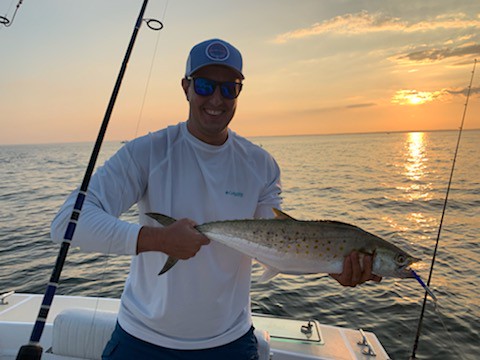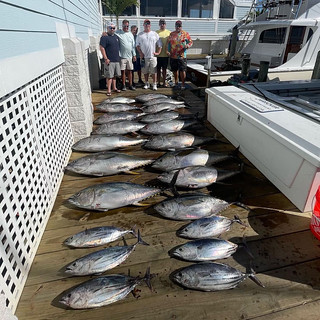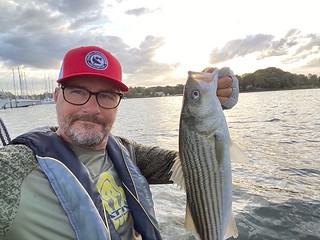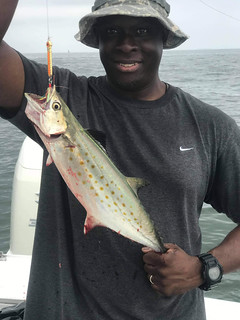Maryland Fishing Report – September 29

Angler Alex Morgan caught a 28-inch Spanish mackerel in the Chesapeake Bay on September 18. Photo courtesy of Alex Morgan.
As September fades into October, cooling temperatures will bring on more true fall-like fishing conditions. Anglers in the upper Chesapeake Bay are putting more focus on the fall striped bass run, while lower Bay anglers are also trying to get their last shots at Spanish mackerel, red drum, bluefish, and spotted sea trout. Fishing for invasives such as northern snakehead, blue catfish, and flathead catfish should be steady for the rest of the fall season.
Forecast Summary: September 29 – October 5:
Some glorious fall days ahead to get out and enjoy Maryland’s Bay waters. Bay conditions will stabilize Thursday, with expected sunny and calmer conditions with cool nights the rest of the week. Bay surface water temperatures continue to cool and are holding in the upper 70s. The improving oxygen and water temperature conditions will continue to provide anglers great boating conditions and more opportunities to catch fish in shallower waters (as well as breaking fish) and the traditional places deeper in the water column such as channel edges, underwater points, hard bottom, and dropoffs.
With cooling waters and windy days, Bay oxygen conditions have improved. Adequate oxygen levels are found at all depths from the Susquehanna Flats to Still Pond and at Swan Point. Due to low bottom oxygen levels, avoid fishing below the following depths in these locations: Bay Bridge to Bloody Point, 25 feet to 45 feet; Choptank River to Point No Point, 25 feet to the bottom. On the Potomac River from Colonial Beach to Piney Point, there is suitable oxygen to the bottom. Conditions can vary daily so be sure to check the depth-to-oxygen level online for your specific location prior to your next fishing trip.
Expect normal flows for most Maryland rivers and streams. There will be above average tidal currents through Monday as a result of the new moon Oct. 6.
Expect average clarity for many of the Maryland portions of the Bay and rivers, except the middle Patuxent, Bush, lower Chester, and Back rivers. In the mainstem, expect poor water clarity from algal blooms along the western shore from the Patapsco River south to Chesapeake Beach. To see the latest water clarity conditions, check Eyes on the Bay Satellite Maps.
For more detailed and up-to-date fishing conditions in your area of the Bay, check the Maryland DNR website for Click Before You Cast. Get regular updates on Maryland’s waters sent to your inbox with our Eyes on the Bay newsletter. Sign up online.
Last week’s heavy rain resulted in the opening of several floodgates at Conowingo Dam. There are now four or less gates open and flows have dropped considerably. The waters of the lower Susquehanna River and below the mouth of the river are still showing stained conditions, but water clarity should be slowly improving. Anglers are casting crankbaits and jigging along the channel edges of the Susquehanna Flats, but many are fishing the tidal rivers on the eastern side of the upper Bay looking for clearer water. The mouth of the Bohemia and Sassafras rivers are great places to start looking for the early morning and late evening shallow-water bite.
Live-lining spot has been a popular and productive method for striped bass through the month of September. However, with water temperatures steadily dropping down into the low 70s, the spot will be thinning out as cooler water temperatures push them south. The usual places to seek striped bass include the Tolchester Lumps, Swan Point, the Love Point Rocks, the mouth of the Magothy River, the Sandy Point Light, and the Bay Bridge piers and rock piles.
Chumming, jigging, and live-lining eels will be a good alternative to using live spot as we get into October. Drifting pieces of soft crab back to pier bases of the Key Bridge and Bay Bridge are always very effective. A mix of large channel and blue catfish can often be part of the mix, whether live-lining or fishing baits of soft crab or cut menhaden.
As water temperatures drop in the upper Bay, trolling along channel edges with umbrella rigs is becoming more popular. Most anglers are using bucktails with curlytails or swimshads. Some are using umbrella rigs with hookless spoons and a single spoon as a trailer; all need plenty of weight to get down to where the striped bass are suspended. A fair percentage of the striped bass being caught are falling short of the keeper length of 19 inches.
Fishing for white perch has been fair to good in the tidal creeks and rivers, but cooler water temperatures will start forcing them into the lower parts of the rivers and out into the Bay. This will be the last chance to find some good morning and evening action along shorelines by casting beetle spins, small spinnerbaits, spinners, and soft plastic jigs. Bottom rigs baited with pieces of bloodworm, peeler crab, and grass shrimp are a good choice when fishing deeper waters.
In the middle Bay the focus will start shifting to striped bass, as the last of the Spanish mackerel are moving down the Bay to warmer waters. The striped bass are being found in waters 5 feet to 10 feet deep along shoreline structure in the morning and evening hours. The slightly cooler waters are making this type of fishing a success with top water lures and paddletails. The Poplar Island rocks, Thomas Point, Black Walnut Point, and other shorelines near the mouths of the region’s rivers are a few of the places to explore.
Cooler waters will be more favorable to striped bass as they begin to hold along channel edges and at the mouths of the tidal rivers. This is the very beginning of a typical fall pattern. By mid and late October, schools of baitfish will be exiting the tidal rivers and striped bass will be stationed along the major channel edges feeding on them. Jigging with soft plastic and metal jigs along these channels will become the front-and-center tactic for anglers. The key will be to use half-ounce to ¾-ounce jigs and braided line on a fast-taper fishing rod. Be prepared to adjust the weight of the lead head or metal jigs depending on water depth, current speed, and wind conditions. Breaking fish can be found by watching for flocks of diving seagulls and terns, and a good pair of binoculars can come in handy for finding this activity.
Trolling with umbrella rigs pulled behind inline weights along these same channel edges will also come into its own. Medium-sized bucktails dressed with soft plastics are popular. Trolling small spoons behind planers or inline weights at slow to medium speeds will catch striped bass and a few bluefish.
After last week’s weather events and cooling water temps, the remaining Spanish mackerel have been moving south with a few larger ones being caught as they feed aggressively prior to departure. The usual high-speed trolling at 7 or 8 knots will catch them, usually along the edges of the shipping channel. When diving seagulls are spotted, trolling around the distant outside edges is a good tactic. Casting small metal and epoxy jigs into the breaking fish is a productive method and allows for use of lighter spinning tackle. Speed reeling will catch the attention of the Spanish mackerel, while slower speeds will allow small bluefish and striped bass to catch up. Good places to look for Spanish mackerel include the Buoy 83 channel edge, near Sharps Island light, in front of Chesapeake Beach along the shipping channel edge, and the False Channel, but keep in mind that these fish will be moving rapidly south towards Solomons.
This is another good week for white perch fishing in the tidal rivers and creeks of the middle Bay. There are still plenty of perch to be found along the shorelines during the morning and evening hours. Beetle spins, soft plastic jigs, and spinners are great lures to cast on light tackle. Fishing with grass shrimp on a simple one-hook bottom rig near dock pier bases is another excellent way to catch them. Some anglers also do well with the two-hook Chesapeake Sabiki rigs tipped with grass shrimp, Fishbites, or bloodworm. Live bull minnows will also catch larger white perch on bottom rigs or under a bobber near shoreline structure.
The annual Chesapeake Bay Foundation Rod and Reef Slam this year runs from October 9-17. This is a unique fishing tournament that celebrates the difference restored oyster reefs are making in the return of healthy, diverse populations of Chesapeake Bay reef fish. The impetus for the tournament is to draw attention to the variety of species that can be found on restored bottom and to increase the awareness of artificial reef and oyster restoration sites.
Anglers will have a multitude of reef locations throughout Maryland’s portion of the Chesapeake Bay and its rivers at which to fish. Instead of focusing on catching the biggest fish, prizes will be awarded for how many species you catch as well as size. Past angler surveys have shown as many as 12 different species being caught in one day at the Clint Waters Reef at Cooks Point. Register for the Slam on the CBF website.
A mix of striped bass, speckled trout, and slot-sized red drum can be found in waters 10 feet to 15 feet deep near shorelines of the lower Potomac and Patuxent rivers. Those fish, along with bluefish, are being caught there by casting paddletails, jigs and plugs.

Angler Frederick Bauer caught a 25-inch spotted sea trout in Tangier Sound. Photo courtesy of Frederick Bauer
Large red drum are being caught and released from Point Lookout to Tangier Sound. A lot of them are being caught by trolling large spoons and rubber hose lures behind inline weights. Some casters from the Point Lookout Fishing Pier got into the catch-and-release action for large red drum by fishing with cut bait rigs. Small bluefish should also be available for shore casters.
Anglers are reminded the cobia season in the Maryland section of Chesapeake Bay closed September 15, and they can no longer be kept.
On the eastern side of the Bay, from Hoopers Island south to Pocomoke Sound, a mix of speckled trout, slot-sized red drum, and small bluefish are being caught along the shorelines. Some large speckled trout and slot-sized red drum are also being caught at the mouths of the tidal creeks draining from the marshes of Tangier Sound, by drifting soft crab baits and casting lures. Kayak anglers are also getting into the action on the large speckled trout.
Spanish mackerel were being caught throughout the main part of the lower Bay along channel edges before the last storm event, and a few should still remain in the area. Many anglers have been trolling small Drone spoons behind planers and inline weights at high speeds of about 7 knots. Others who prefer light tackle are watching for diving seagulls and slowly approaching from upwind and drifting into the action, to avoid spooking the fish. Casting small epoxy jigs or metal into the breaking fish and reeling fast will entice the Spanish mackerel to strike. The Spanish mackerel have been mixed with bluefish, small striped bass, and a few large red drum.
There is still some live-lining of spot along the channel edge between St. Georges Island and Piney Point, with some nice striped bass being caught, if you can find spot for bait. Others are jigging at the same location, or trolling umbrella rigs down deep along the steep channel edge there. Point No Point and the Cedar Point rips are also good locations for striped bass in fall.
Spot are still holding in the lower Patuxent and Potomac rivers, but they will start moving out soon. They can also be found in Tangier Sound along with a mix of white perch and small croakers. A lot of small flounder are being reported by those bottom fishing on the western side of the Bay. In Tangier and Pocomoke sounds, some larger flounder are being caught on the hard-bottom shoal channel edges. Most are using strips of cut spot or white and pink Gulp baits.
Some very large and heavy blue crabs will be caught in October. Most crabbers are reporting the largest crabs in deeper waters of 10 feet to 15 feet. There are plenty of legal-sized crabs in shallower waters. Most recreational crabbers are able to put together a half-bushel catch per outing, and some are catching a full bushel. There is often a run of large crabs in the tidal rivers such as the Severn in early October. Trotlining with chicken legs and clams is a popular method, but some folks use traps when crabs become finicky and do not hold onto trotline baits.
The cooler nights are starting to cause water temperatures to slowly drop, which is a good thing for freshwater anglers across Maryland. Various species of fish will begin to become more active as they feel the urge to feed more, and boat traffic is now reduced.

Angler Larry Allman caught this 30-inch northern snakehead in Middle River. Photo courtesy of Larry Allman.
Deep Creek Lake anglers are enjoying less boat traffic and more quiet fishing conditions. Smallmouth bass can be found on rocky points and sunken wood, largemouth bass are being found in the cove areas and near floating docks that have not been pulled yet. Yellow perch, walleye, and smallmouth bass are holding along the edges of deep grass — drifting minnows are one of the best ways to target them. Large bluegills can be found in a variety of areas and using small jigs is a great way to target them. Crickets and mealworms also work well. Look for northern pike to start hitting soon, as waters cool in October.
The upper Potomac River is fishing well right now, and anglers can look forward to good fishing for smallmouth bass. Current breaks, submerged ledges, and deep pockets behind boulders are all good places to target. A variety of small crankbaits, tubes, and soft plastic crawfish imitations are good choices for baits.
The fall trout stocking program is set to begin in early October, and trout management waters across the state will be receiving generous stockings of trout. The put-and-take areas are often the most popular, and many are close to population centers so anglers do not have to drive far to enjoy catching trout, which will be mainly rainbows.
Largemouth bass fishing remains in a bit of a summer mode of feeding behavior — the fish may linger in the shallows and will be feeding longer into the day, especially on cloudy days. Casting frogs and buzzbaits over grass and lily pads is always a fun way to target them. Northern snakeheads will be holding in these same areas and can provide some explosive strikes. This is one of the best times of the year to target northern snakeheads because they are feeding aggressively and still holding near grass and shallow structure.
Crappie can be found schooled up near deep structure and targeted with small jigs and minnows under a slip bobber. Bluegills are always ready for action in community ponds and most any piece of water. Blue and channel catfish occupy every tidal river within the Chesapeake Bay watershed and provide plenty of fishing action.

This lucky group of anglers got into a big catch of tuna, including some large yellowfin, off Ocean City. Photo by Scott Lenox
In the surf, a mix of kingfish, spot, and croaker are being caught on bloodworms and Fishbites, when water conditions are favorable between storm and rain events. Increasing numbers of small bluefish are taking pieces of cut spot and mullet baits, and a few pompano and small black drum are being caught on sand fleas. The pompano may move out soon if water temperatures cool down significantly. The anglers fishing with large cut baits are finding some large red drum and enjoying exciting catch-and-release fishing.
At the inlet, a mix of sheepshead and triggerfish have been taking sand fleas near the South Jetty rocks, but they will start moving south soon. Striped bass are holding in the inlet; working bucktails and soft plastics along the bottom in the morning and evening hours is a good way to catch them now until early December. Flounder are also present and soon will be flowing to offshore waters, so the inlet will be a great pinch point to target them in the coming weeks.
The back bay channels are another place to look for flounder for another week or two, as they move towards the inlet and offshore. Drifting along with squid strips, minnows, or Gulp baits is the way to target them, and the catch will depend on water temperatures and clarity.
Outside the inlet, the boats that are targeting flounder on the inshore shoals, wreck sites, and artificial reef sites and catching some impressive flounder and decent numbers of sea bass. A few smaller mahi were being caught inshore around the reefs too, but they will keep moving offshore with cooler weather. There were still some Spanish mackerel in the inshore areas prior to the last storm system, and they can be caught by trolling Drone and Clark spoons behind inline weights. False albacore have been showing up in inshore waters for the last couple of weeks and taking a variety of trolled lures.
The offshore season is winding down, but the boats heading out to the canyons on good weather days are still seeing a few white marlin, along with some impressive catches of large yellowfin tuna and dolphin. Those taking the time for some deep drop fishing are bringing in catches of golden and blueline tilefish.
“Sharing the fun of fishing turns strangers into friends in a few hours.” — Eugenie Clark, “The Shark Lady”
Maryland Fishing Report is written and compiled by Erik Zlokovitz of Maryland Department of Natural Resources recreational fisheries outreach.
Click Before You Cast is written by Tidewater Ecosystem Assessment Director Tom Parham.
This report is now available on your Amazon Echo device — just ask Alexa to “open Maryland Fishing Report.”



 1-888-373-7888
1-888-373-7888 233733
233733